IT Outsourcing – Overview and General Information
How big is the global IT Outsourcing market?
According to GrandViewResearch, the global IT services market (inhouse and provided by third parties) was worth around $1250 billion in 2022. Revenues are forecast to reach $1364 billion in 2023. The largest market within IT services is the IT outsourcing (ITO) market: this is expected to reach $430.53 billion in 2023 and rise to $587.3 billion by 2027, according to Statista.
This corresponds to a compound annual growth rate (CAGR) of 8.07% for the ITO market between 2023 and 2027, and a CAGR of 6.68% is expected for the overall IT services market between 2023 and 2027. The ITO share of the overall IT market is therefore expected to continue to grow.
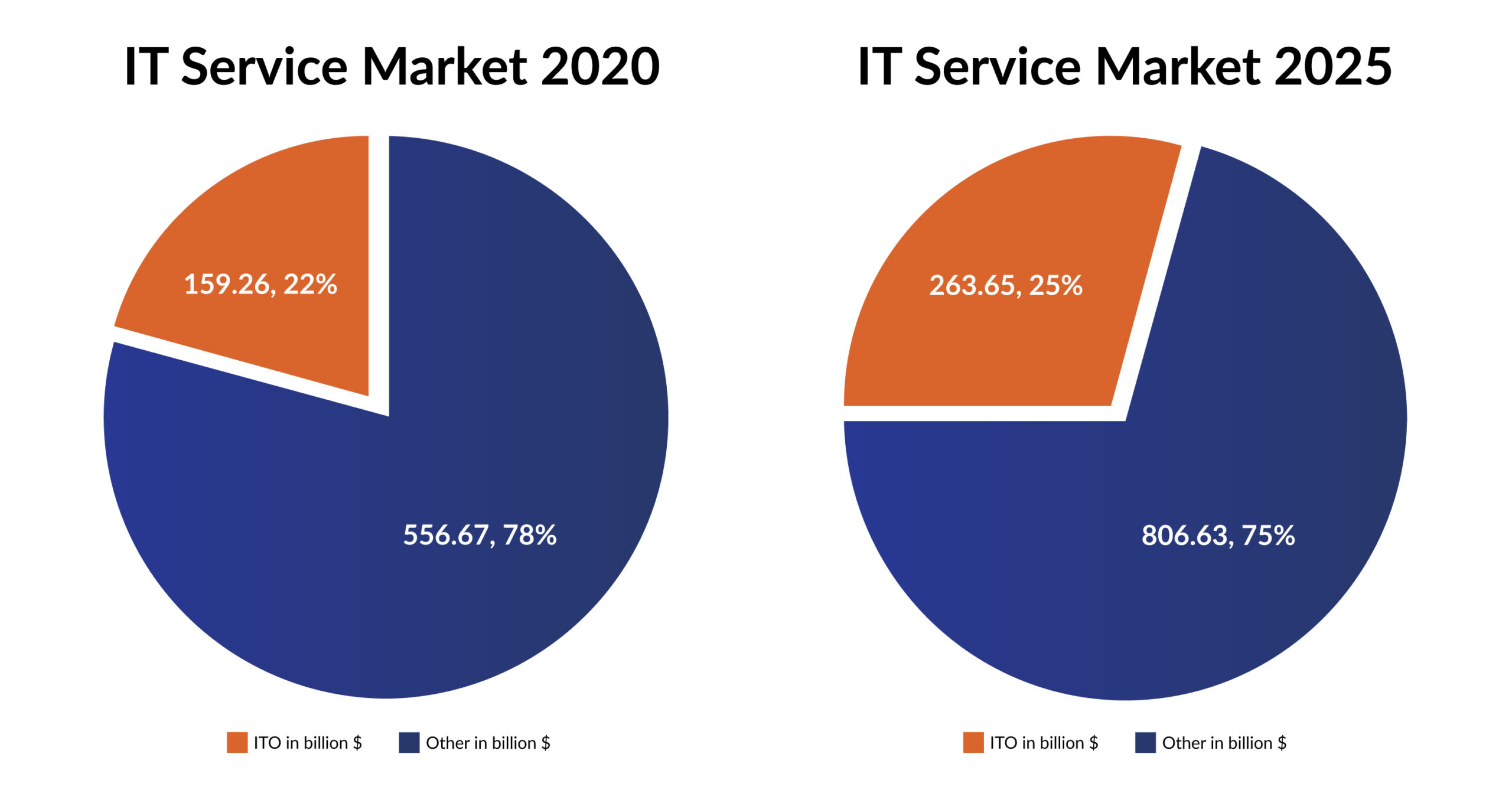

Depending on the type of methodology used to analyse and collect data, the value of the IT outsourcing market varies widely. Grand View Research projects a market value of $821.58 billion in 2022 for the IT services market and a CAGR between 2023 and 2030 of 9.1%. The ITO market was estimated by Grand View Research to be worth USD 520.74 billion in 2019 and forecast a CAGR of 7.7% between 2020 and 2027 (more recent data was not available at the time of writing).
GlobeNewswise speaks of just under $320 billion in 2020 (ITO market value) and forecasts it to rise to $425.19 billion in 2026, with a CAGR of 4.5% over that period.
Sources: Grand View Research IT market / IT Outsourcing market, Statista, Globe Newswise
Is there a tech talent shortage?
According to a McKinsey study, 87% of respondents said as early as 2020 they either are experiencing gaps in their IT teams now due to recruitment bottlenecks or expect them within a few years.


Source: McKinsey
Many other sources support this statement, and the extent of the global IT skills shortage has increased significantly. According to Staffing Partner, in 2022, 75% of recruiters reported being unable to find sufficiently qualified candidates.
According to a recent report by Man Power Group, in 2023, 4 out of 5 employers worldwide report difficulty finding suitable staff. At 86%, Germany is in second place behind Taiwan (90%).
At 78%, the shortage in the IT sector is similar to that in other industries. As a result, 55% of employers are willing to hire talent from outside their own country (especially in the IT sector).


Source: Manpower Group
What are the most in demand tech skills?
According to Statista, web development is the most sought-after tech skill in 2023. 58.53% of all employees surveyed said they were looking for staff with web development skills. This was followed in second place by DevOps (35.55%) and in third place by Database Software (27.5%). Still, nearly a quarter of all workers are looking for staff with skills in AI / Machine Learning / Deep Learning (24.6%).
After 2021, technical skills such as quantum computing, connected technologies, and fintech and AI are expected to be the fastest-growing areas for increasing demand for technical skills.
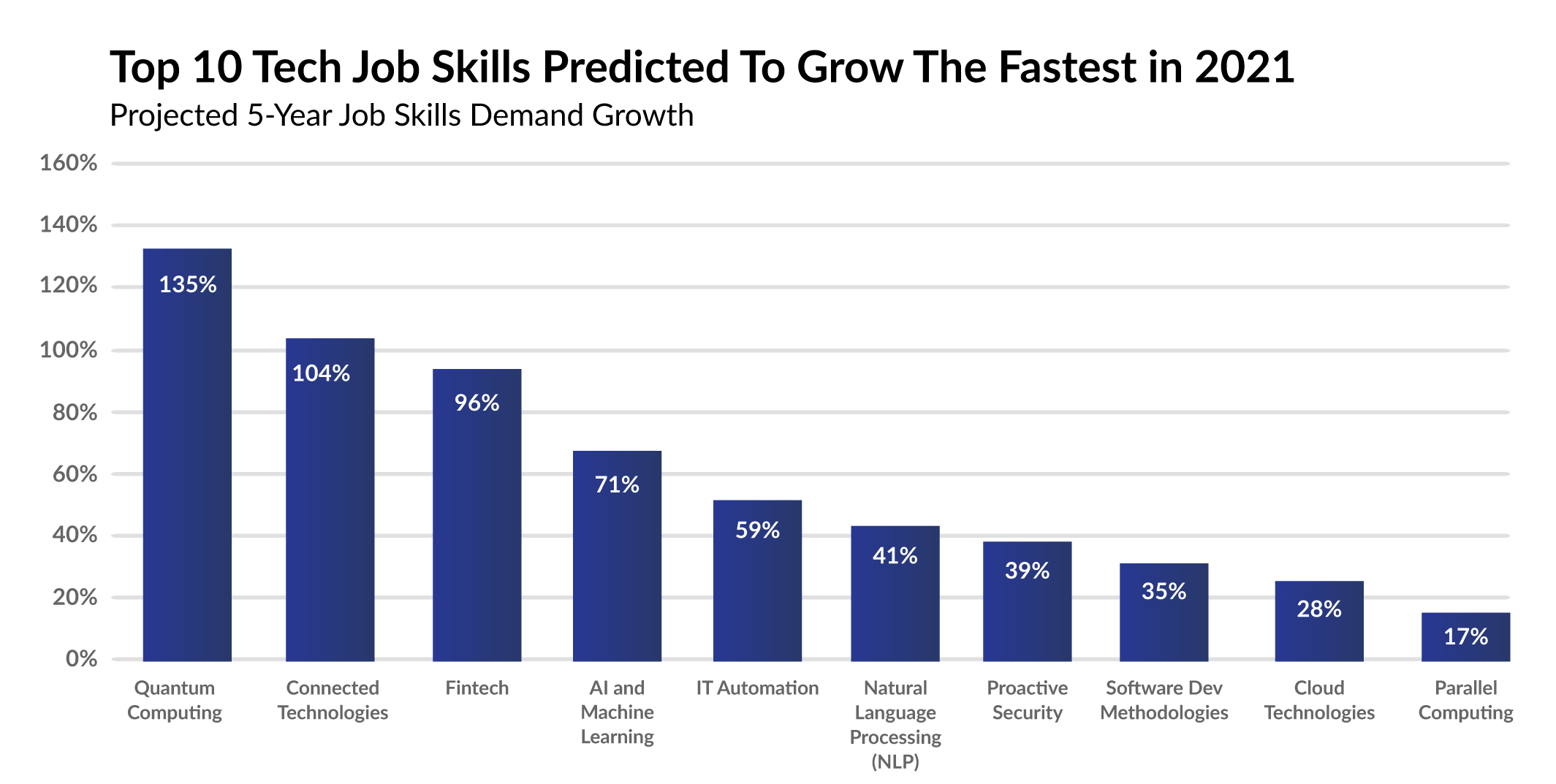

Source: Forbes
What are the most in demand IT technologies?
The most sought-after programming languages in 2022 were:
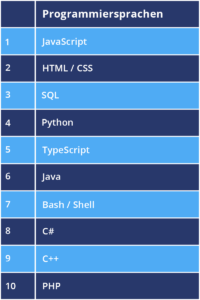

Source: Statista
Why IT outsourcing is so important
Technology leaders China and the US could soon face an incredible IT skills shortage, according to management consulting firm Korn Ferry. This would give India the opportunity to take the lead as the world’s most technologically capable nation, with an expected 1 million IT professionals by 2030. If the US and China do not find an internal solution to their IT talent shortages, which currently seems unlikely, IT outsourcing will become even more strategically crucial to their continued development.
Sources: Korn Ferry, Classic Informatics,
Which countries have the most programmers?
The chart below shows the European countries with the most programmers. As expected, the countries with the largest economies and populations, Germany and the UK, have many developers. Countries from Central/Eastern Europe with many developers and which are often described as interesting IT outsourcing locations are for example Poland and Ukraine.
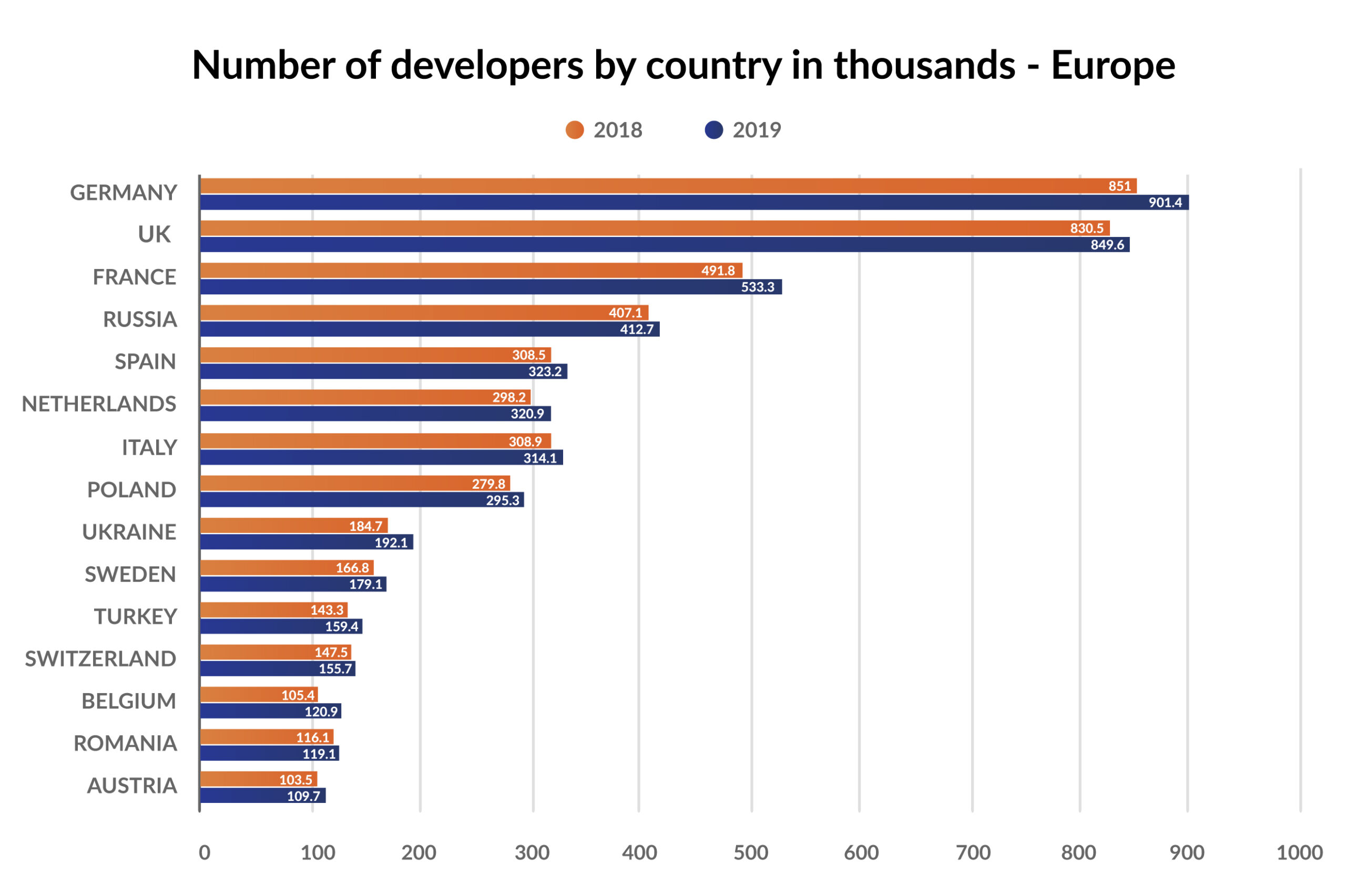

The data shown here is from 2018 and 2019, as this data has not been covered since then. The total number of software developers worldwide has been steadily increasing in recent years, from 23 million in 2018 to 25.6 million in 2021, and is expected to rise further to 27.7 million in 2023 and 28.7 million in 2024.


Source: The State of European Tech
IT Outsourcing market overview
- In 2023, the IT outsourcing market is expected to generate global revenues of €420,000 billion.
- With an expected compound annual growth rate (CAGR) of 7.49%, the market will reach a value of €560.70 billion by 2027.
- In IT outsourcing, employee spending is expected to average €120.50 in 2023.
The U.S. is expected to account for the largest share of market revenue in 2023 at €152.40 billion. - The top three areas in the IT outsourcing segment are web hosting, application outsourcing, and administration outsourcing. Together they account for 63.5% of the market value.
- More than three-quarters of all executives said they would outsource IT functions in 2022. Among them, cybersecurity ranked first, followed by app and software development and IT infrastructure services.
- Organizations are increasingly spending more money on IT outsourcing: in 2022, 67% of executives reported an increase in budget for Operated Services, 57% reported spending more money on Managed Services, and 32% increased their budget for traditional outsourcing.
- The most important reasons for IT outsourcing are access to new technical as well as personnel opportunities and cost savings.
Source: Statista, Deloitte Global Outsourcing Survey 2022
IT-Service exports by country
The largest export countries of information & communications technologies (ICT) are large or well-developed economies like India, USA, China, UK, Ireland and Germany. However, the graphic below shows how important IT exports are for Eastern European countries, for whom IT services account for a disproportionate share of overall service exports.
Examples of high-income countries from Europe that generate a particularly high proportion of their service exports with IT services are Finland and Ireland and Ukraine and Belarus examples of low/middle-income countries. IT services account for more than 30 % of export services provided in these countries.
Important trends can be seen in ICT export growth, for example: ICT exports in Ireland and Ukraine each grew by 158% from 2017 to 2021. By comparison, ICT exports in Germany and the UK grew by only 39% each in the same period, and by only 28% in North America.
Other countries outside Europe that export a particularly high percentage of IT services are for example India, Israel, Pakistan and Armenia.


Source: World Bank Group, Nation Master
How many companies use IT Outsourcing services?
The figures presented here are for G2000 companies, over 90% of which have held ongoing ITO contracts in the last 5 years.


Other market research analyses come up with similar figures and KGMB offers more details on the extent to which IT outsourcing is taking place.


Will the IT outsourcing sector continue to grow?
In 2022, 49.6% of companies said they intended to increase their outsourcing share. 40% foresaw no change, while only 10.4% wanted to reduce outsourcing. It can therefore be assumed that the outsourcing market will continue to grow.


Source: Computer Economics (US & CA)
Is IT outsourcing expensive?
For companies that outsource app development functions, 40% of outsourcing customers have higher costs and 31% have lower costs compared to in-house development. About 29% said they do not notice a significant financial difference between outsourcing app development and in-house development.


Source: Avasant
Which sectors rely most on IT outsourcing?
The sector a company is in has an influence on the tendency to outsource IT functions. The following figure shows the sectors that outsource app development with average frequency. Across sectors, an average of almost 60% of organisations outsource app development. In the financial services sector, that rises to 72%, followed by retail/wholesale companies at 60%. Further down the list are companies in the healthcare sector at a relatively modest 31%.


Source: Computer Economics
Which is better IT outsourcing or insourcing?
- The Top reasons for IT Outsourcing are cost reduction (71%), business transformation (50%) and improving service quality (50%) (UK).#
- The Top reasons for shifting IT functions in-house are faster time to market and improved quality (88%), the need to build and control their intellectual property (63%) and the challenge of working with providers in Agile/DevOps teams (58%) as key drivers (UK).
Source: PA Consulting (UK)
Why is IT outsourcing good for organisations?
Globally, cost reduction is the primary reason for Outsourcing. Only a minority of organisations that use outsourcing say that cost is not important to their strategy.
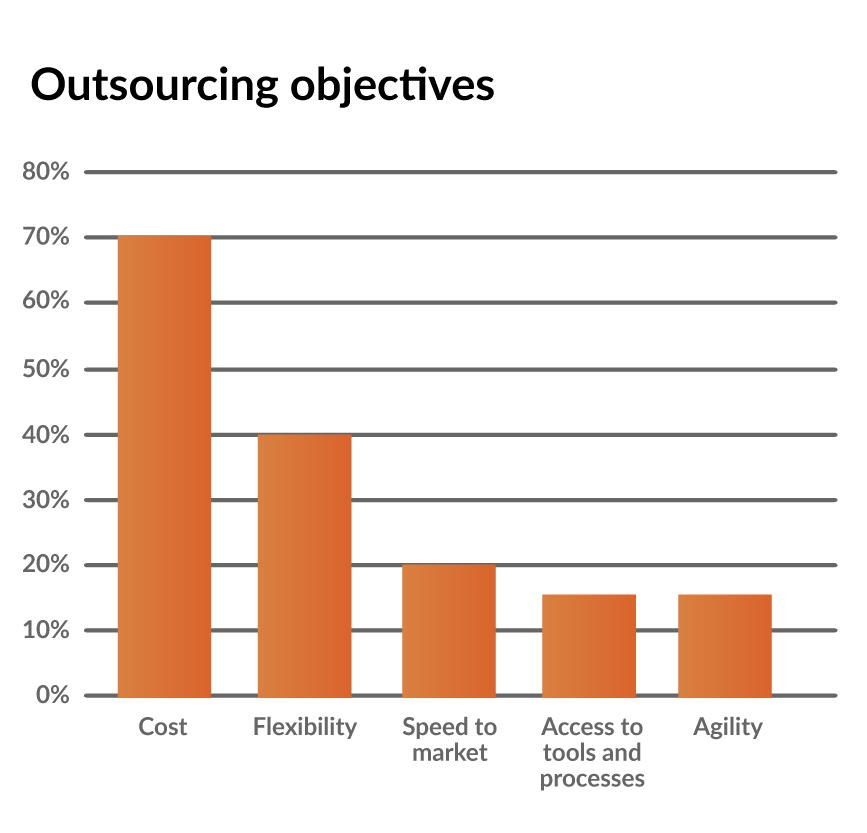

Source: Deloitte
IT outsourcing for small businesses
- According to the data collected, the biggest challenge for small businesses is hiring new employees (50%).
- Also, employee health care costs are among the biggest challenges faced by small businesses in the USA at 44%.
For small companies, IT outsourcing can be a useful means of countering the above-mentioned challenges, which are particularly difficult for small companies, because they are largely taken care of by the IT outsourcing service provider.
K&C - Creating Beautiful Technology Solutions For 20+ Years . Can We Be Your Competitive Edge?
Drop us a line to discuss your needs or next project









